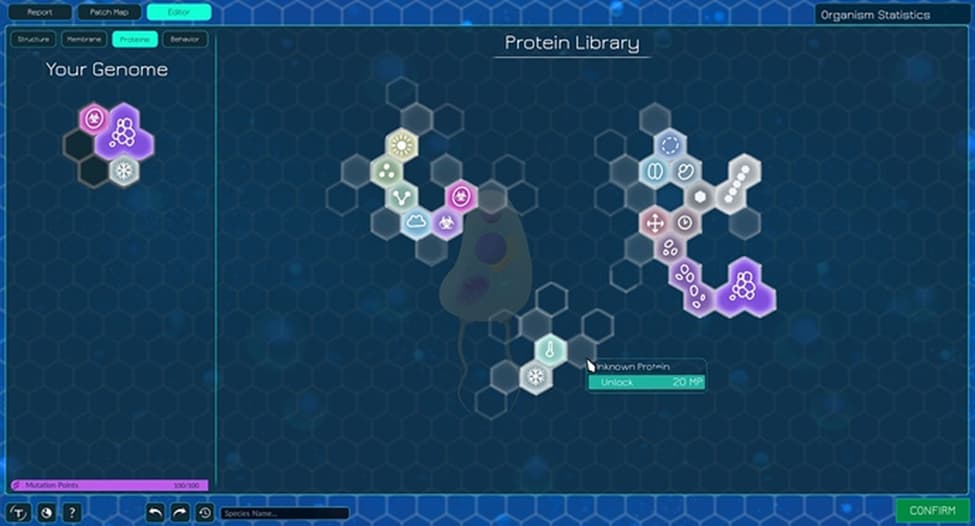So I looked through the development forum and saw this thread (Passive Enzyme/Protein Slots System - #34 by Narotiza - Gameplay - Thrive Development Forum) with a concept for how enzymes would work. It basically has a sort of “slot” system where a player will have a certain amount of hexes they can place various enzymes in which do various things.
Different enzymes will have different characteristics which influences the way a creature looks or behaves: for example, membrane proteins benefit from more surface area (more membrane), so they’d want to be kind of long. Or cytoplasmic proteins benefit from more cytoplasm, so they’d want to be as large as possible.
I like this idea. It adds a soft cap on how many enzymes are equipped with the number of free hexes available to the player, meaning players will have to choose and make concessions for the greater good of their species. As such, the hyper-generalist murder machines we see in game today that make water bears look like earthworms will be no more – why would you keep a bunch of unnecessary environmental tolerances in your genome when you could use that space for more useful adaptations? It also is a pretty broadly applicable concept with many potential uses and future synonyms. Perhaps advanced behaviors, like hibernation or migration and such, can have their own genome slots to be placed.
I have a few questions and observations, however.
- The hydrothermal vents probably require their own enzymes to protect against the environmental heat and pressure. Knowing this, your genome is probably already going to have those two genes in your slots as soon as you start your game. Perhaps when you start out, you only have three genome/enzyme slots open – two taken up by “highpressurease” and “temperaturease”, one free. I think this allows an easy tutorial setup/ an easy introduction for the player to the tab. The two existing proteins will be explained, and then the player will be prompted to place another protein. Perhaps hydrogen sulfide can initially be damaging to the player, but placing a genome allows it to be synthesized. And then the player is prompted to place this genome onto theirs as an introduction.
- The extent to which this concept holds control over your cells adaptation and the way it interacts with the existing organelle system will have to be further defined. I think a lot of this will be made easier by creating the roster of enzymes/genes you can place, but what I mean is that I’m sure there will be overlaps in functions between organelles and genes, and that overlap needs to be defined. For example, say there’s an enzyme focused on oxygen tolerance/aerobic respiration. Metabolosomes already cover that aspect of the game currently. Do you need to place the oxygen gene to unlock metabolosomes? Or does the oxygen gene simply dramatically enhance the function of metabolosomes? Or does it add the aerobic aspect of the metabolosome’s duty? I think these are pretty easy questions to answer with enough thought, but they still need to be answered.
- A lot still needs to be drawn out surrounding the two most critical environmental adaptations in life’s evolutionary history: oxygen tolerance and protection against radiation from the sun. I think the current concept says that once a cell takes in too much oxygen/sunlight/whatever harmful compound, they will start feeling negative effects, and the player can counteract this by evolving ways to get rid of these stored compounds more rapidly, which sounds really fun. But what part of this evolutionary function will be represented by upgrading organelles and what part of this evolutionary function will be represented by placing a gene? Perhaps the gene significantly increases the rate at which metabolosomes interact/get rid-off of oxygen? Tolerance for the sun is a bit easier; I think having an enzyme which significantly increases tolerance for sunlight is simple enough.
Other than that, I think it’s a very good concept. Merry Christmas
